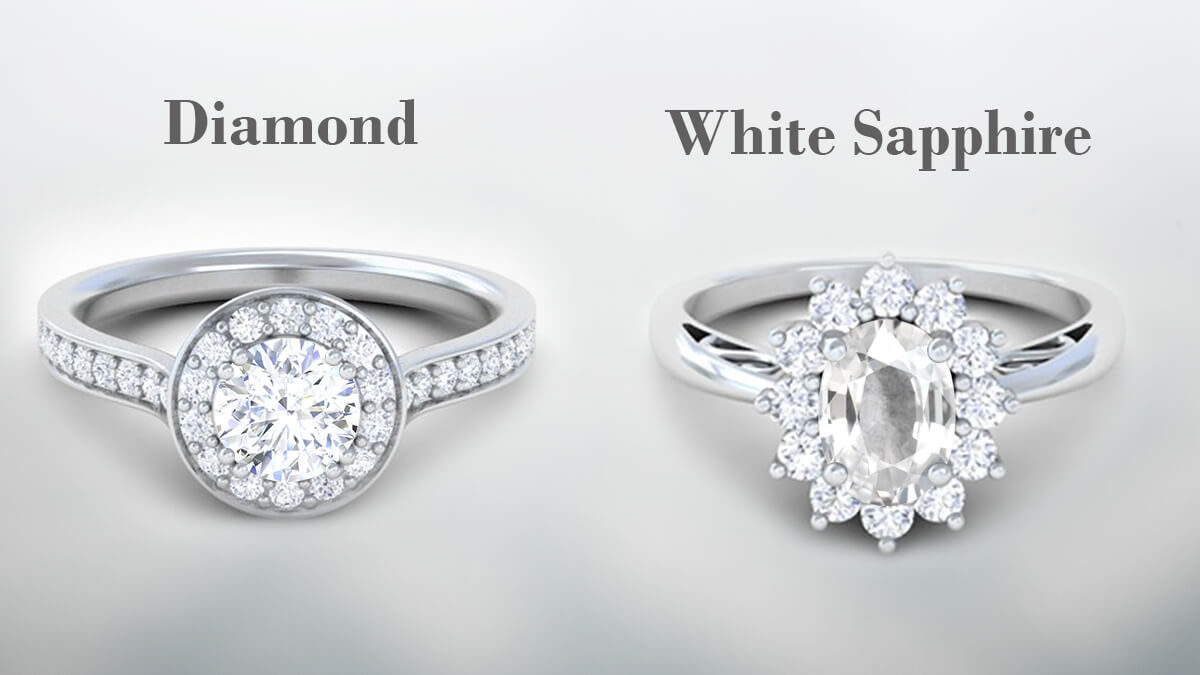When it comes to choosing a gemstone for an engagement ring or other fine jewelry, two popular options are diamonds and white sapphires. Both are stunning choices, but they differ in terms of their appearance, durability, cost, and environmental impact. In this article, we will explore the differences between diamond vs white sapphire, with a particular focus on the growing trend of lab-made diamonds.
Table of Contents
Understanding the Basics: Diamond vs White Sapphire
Diamonds and white sapphires are often compared due to their similar appearance. Both stones are clear and colorless, making them desirable choices for various types of jewelry. However, their origins and composition set them apart. Diamonds are a natural form of carbon that have been formed over millions of years under extreme pressure and heat deep within the Earth. In contrast, white sapphires are a type of corundum, a mineral made of aluminum oxide, which can be found in nature or created synthetically.
The Appearance of Diamond vs White Sapphire
When comparing diamond vs white sapphire in terms of appearance, diamonds have a unique sparkle that is often described as fiery and brilliant. This brilliance comes from the way diamonds reflect light through their many facets. White sapphires, while also clear, do not possess the same level of brilliance. Instead, they tend to have a softer, subtler shine, which may appeal to those who prefer a more understated look.
Lab-made diamonds have the same appearance as natural diamonds. They are chemically identical and exhibit the same brilliance and sparkle. This makes them a strong contender in the diamond vs white sapphire debate, as they offer the same visual appeal at a lower cost.
Durability and Hardness: Diamond vs White Sapphire
In terms of durability, diamonds are the hardest known natural material on Earth, scoring a 10 on the Mohs scale of hardness. This makes them highly resistant to scratching and ideal for daily wear. White sapphires, on the other hand, are not as hard, scoring a 9 on the Mohs scale. While still quite durable, white sapphires are more prone to scratches compared to diamonds, especially if subjected to rough wear.
Lab-made diamonds share the same hardness as natural diamonds, making them just as durable and scratch-resistant. This gives lab-made diamonds an edge over white sapphires for individuals seeking a gemstone that will maintain its pristine appearance over time.
Cost Comparison: Diamond vs White Sapphire
Cost is one of the key factors that often influences the decision between diamond vs white sapphire. Natural diamonds can be quite expensive due to their rarity and the extensive mining process involved. lab made diamonds, however, are generally much more affordable, making them a popular choice for those on a budget.
Lab-made diamonds, while still generally more expensive than white sapphires, tend to be more affordable than their natural counterparts. The price difference between lab-made diamonds and natural diamonds is significant, but it remains higher than that of white sapphires. As lab-made diamonds continue to grow in popularity, their price is expected to become more competitive, offering consumers a quality alternative to both natural diamonds and white sapphires.
Ethical Considerations: Lab-Made Diamonds vs Natural Diamonds
Ethical concerns around the diamond industry have become more prevalent in recent years, with many consumers seeking conflict-free options. Natural diamonds, particularly those mined in regions with poor labor conditions, have been associated with human rights abuses and environmental damage. White sapphires, while often less controversial, can still come from sources with questionable mining practices.
Lab-made diamonds, however, offer a more ethical choice. These diamonds are grown in controlled environments using sustainable practices that do not involve harmful mining. Choosing a lab-made diamond can help mitigate the environmental and ethical concerns associated with natural diamonds. In the debate of diamond vs white sapphire, lab-made diamonds emerge as the environmentally friendly and ethical option.
The Environmental Impact: Lab-Made Diamonds vs Natural Stones
Mining natural diamonds has a significant environmental impact, with large-scale excavation disrupting ecosystems, consuming vast amounts of energy, and generating considerable waste. While white sapphires are often less destructive to mine, they are still not as eco-friendly as lab-made diamonds.
Lab-made diamonds, on the other hand, have a minimal environmental footprint. They are created in laboratories using advanced technology that requires fewer resources and causes less environmental damage. This makes lab-made diamonds a more sustainable option when compared to both natural diamonds and white sapphires. For environmentally-conscious consumers, lab-made diamonds are a compelling choice in the diamond vs white sapphire conversation.
Conclusion: Diamond vs White Sapphire – Which is the Better Choice?
The decision between diamond vs white sapphire depends on a variety of factors, including personal preference, budget, and ethical considerations. Diamonds are the epitome of luxury and brilliance, while white sapphires offer a more budget-friendly, subtle alternative. Lab-made diamonds provide a unique combination of the beauty and durability of natural diamonds, without the associated ethical and environmental concerns.
For those seeking a gemstone that combines brilliance, durability, and ethical sourcing, lab-made diamonds are an excellent option. Whether you choose a lab-made diamond or a white sapphire ultimately comes down to your personal values, preferences, and budget. However, as the world continues to prioritize sustainability and ethical practices, lab-made diamonds are likely to become an increasingly popular choice.

